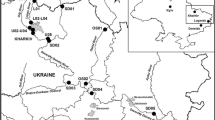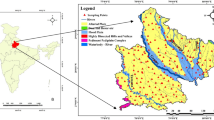Abstract
In order to assess the quality and suitability of waters in the Kor–Sivand river basin, 60 water samples from the Kor river and 90 water samples from wells in the basin were studied. Assessments were based on Piper’s and Gibbs’ diagrams for water quality, Food and Agricultural Organization’s (FAO) guidelines, and US Salinity Laboratory diagram for water suitability. The results showed that the river water is of Ca–HCO3 type, while well water is of Ca–Cl and Na–Cl type. Based on Gibbs’ diagram, the source of soluble ions in the river water samples is the weathering of stones over which water flows, while evaporation was found to be the dominant process in the ion concentration of the well samples. According to the FAO Guidelines, the salinity of surface water for irrigation did not cause great restrictions; however, many of these waters could create potential permeability problems. In the groundwater samples, a high salt concentration is more important than the infiltration problem. Mg hazard values at some sites limit its use for agricultural purposes. One third of the river water samples and two thirds of well waters had more than 50% magnesium. Saturation indices showed that 94% of the analyzed water samples are supersaturated with calcite, aragonite, and dolomite. Based on the US Salinity Laboratory diagram, river water samples were classified as C2S1 and C3S1, while C4S3, C4S4, C2S1, and C3S1 were the most dominant classes in well samples. Some management practices necessary for sustainable development of water resources in the study area were discussed briefly, including appropriate selection of crops, adequate drainage, leaching, blending and cyclic use of saline water, proper irrigation method, and addition of soil amendment.






Similar content being viewed by others
References
Al-Bassam, A. M., & Al-Rumikhani, Y. A. (2003). Integrated hydrochemical method of water quality assessment for irrigation in arid areas: Application to the Jilh aquifer, Saudi Arabia. Journal of African Earth Sciences, 36, 345–356.
Aloui, B. Z., & Gueddari, M. (2009). Long-term water quality monitoring of the Sejnane reservoir in northeast Tunisia. Bulletin of Engineering Geology and the Environment, 68, 307–316.
Ashraf, M., & Saeed, M. (2006). Effect of improved cultural practices on crop yield and soil salinity under relatively saline groundwater applications. Irrigation and Drainage Systems, 20, 111–124.
Ayers, R. S. & Westcot, D. W. (1985). Water quality for agriculture. Rome: Food and Agriculture Organization of the United Nations, No. 29.
Bartram, J., & Helmer, R. (1996). Introduction. In J. Bartram & R. Balance (Eds.), Water quality monitoring—A practical guide to design and implementation of freshwater quality studies and monitoring programmes (pp. 1–8). London: E & RFN Spon.
Berner, E. K., & Berner, R. A. (1987). The global water cycle: Geochemistry and environment. Englewood Cliffs: Prentice-Hall (397 pp).
Borucki, W., & Sujkowska, M. (2008). The effects of sodium chloride-salinity upon growth, nodulation, and root nodule structure of pea (Pisum sativum L.) plants. Acta Physiologiae Plantarum, 30, 293–301.
Brodribb, T. J., & Holbrook, N. M. (2005). Water stress deforms tracheids peripheral to the leaf vein of a tropical conifer. Plant Physiology, 137, 1139–1146.
Charlton, S. R., Macklin C. L., & Parkhurst D. L. (1997). PHREEQCI-A graphical user interface for the geochemical computer program PHREEQC. U.S. Geological Survey Water-Resources Investigations Report 97-4222, 9 pp.
Drever, J. I. (1988). The geochemistry of natural waters (2nd ed.). Englewood Cliffs: Prentice-Hall (437 pp).
Dreybrodt, W. (1992). Theoretical and experimental results on kinetics of calcite dissolution and precipitation. In G. Matthess, F. Frimmel, P. Hirsch, H. D. Schulz, & H. E. Usdowski (Eds.), Progress in hydrogeochemistry (pp. 103–112). Berlin: Springer.
Egun, N. K. (2010). Effect of channelling wastewater into water bodies: A case study of the Orogodo River in Agbor, Delta State. Journal of Human Ecology, 31(1), 47–52.
Frenkel, H. (1984). Reassessment of water quality criteria for irrigation. In I. Shainberg & J. Shalhevet (Eds.), Soil salinity under irrigation. Process and management (pp. 298–318). Berlin: Springer.
Frenkel, H., Goertzen, J. O., & Rhoades, J. D. (1978). Effect of clay type and content, exchangeable sodium percentage and electrolyte concentration on clay dispersion and soil hydraulic conductivity. Soil Science Society of America Journal, 42, 32–39.
Ghassemi, F., Jakeman, A. J., & Nix, H. A. (1995). Salinisation of land and water resources: Human causes, extent, management and case studies. Sydney: UNSW Press.
Gibbs, R. J. (1970). Mechanisms controlling world water chemistry. Science, 17, 1088–1090.
Girdhar, I. K. (2003). Role of magnesium in affecting soil properties and plant growth in salt affected soil. In P. Lal, R. B. Chippa, & A. Kumar (Eds.), Salt affected soils and crop production: A modern synthesis. India: Agrobios.
Giridharan, L., Venugopal, T., & Jayaprakash, M. (2009). Identification and evaluation of hydrogeochemical processes on river Cooum, South India. Environmental Monitoring and Assessment, 162, 277–289.
Grattan, S. R., Oster, J. D., Benes, S. E., & Kaffka, S. R. (2009). Use of saline drainage waters for irrigation. In W. W. Wallendar and K. K. Tanji (Eds.), Agricultural salinity assessment and management (2nd ed.). New York: ASCE, pp. 433–449.
Gupta, R., & Abrol, I. (1990). Salt-affected soils: Their reclamation and management for crop production. Advances in Soil Science, 11, 223–288.
Gupta, S., Mahato, A., Roy, P., & Datta, J. K. (2008). Geochemistry of groundwater, Burdwan District, West Bengal, India. Environmental Geology, 53, 1271–1282.
Gupta, S., Dandele, P. S., Verma, M. B., & Maithani, P. B. (2009). Geochemical assessment of groundwater around Macherla–Karempudi Area, Guntur District, Andhra Pradesh. Journal Geological Society of India, 73, 202–212.
Hojjati, M. H., & Boustani, F. (2010). An assessment of groundwater crisis in Iran case study: Fars province. World Academy of Science, Engineering and Technology, 70, 476–480.
Hounslow, A. W. (1995). Water quality data: analysis and interpretation. New York: CRC (397 pp).
Isaac, R. K., Khura, T. K., & Wurmbrand, J. R. (2009). Surface and subsurface water quality appraisal for irrigation. Environmental Monitoring and Assessment, 159, 465–473.
Jalali, M. (2007). Hydrochemical identification of groundwater resources and their changes under the impacts of human activity in the Chah Basin in western Iran. Environmental Monitoring and Assessment, 130, 347–367.
Jambandy Motaleat. (1987). Comprehensive studies for agricultural development. Kor-Sivand, shapor- Dalaki, Mond-Saheli watersheds, Synthesis Report, Ministry of Agriculture, Department of Planning and Budget, Tehran, Iran. (In Persian).
Kovda, V. A., Yaron, B., & Shalhevet, Y. (1973). Quality of irrigation water. In V. A. Kovda, C. V. Berg, & R. M. Hagan (Eds.), International source book on irrigation, drainage and salinity (pp. 177–205). London: Hutchinson/FAO/UNESCO.
Maas, E. V., & Hoffman, G. J. (1977). Crop salt tolerance—Current assessment. Journal of the Irrigation and Drainage Division, 103, 115–134.
Marschner, H. (1995). Mineral nutrition in higher plants. London: Academic.
Mathess, G. (1982). The properties of groundwater. New York: Wiley (406 pp).
Miyamoto, S., & Stroehlein, J. L. (1986). Sulfuric acid effects on water infiltration and chemical properties of alkaline soils and water. Transactions of the American Society of Agricultural Engineers, 29(5), 1288–1296.
Mohan, R., Singh, A. K., Tripathi, J. K., & Chaudhary, G. C. (2000). Hydrochemistry and quality assessment of groundwater in Naini industrial area, District Allahabad, Uttar Pradesh. Journal of the Geological Society of India, 55, 77–89.
Motaleat Jame (1999). Comprehensive studies for agricultural development. Kor-Sivand basin. YEKOM Consulting Engineers, Ministry of Agriculture, Tehran, Iran (in Persian).
Munns, R., & Tester, M. (2008). Mechanisms of salinity tolerance. The Annual Review of Plant Biology, 59, 651–681.
Olum Zamin (1987). Comprehensive studies for agricultural development. Kor-Sivand, shapor- Dalaki, Mond-Saheli watersheds, volume 4: Geology. Ministry of Agriculture, Tehran, Iran (in Persian).
Oster, J. D. (1982). Gypsum usage in irrigated agriculture: A review. Fertilizer Research, 3, 73–89.
Oster, J. D., & Schroer, F. W. (1979). Infiltration as influenced by irrigation water quality. Soil Science Society of America Journal, 43, 444–447.
Pandey, S. K., Singh, A. K., & Hasnain, S. I. (2001). Hydrochemical characteristics of melt water draining from Pindari glacier, Kumon Himalaya. Journal of the Geological Society of India, 57, 519–527.
Piper, A. M. (1944). A graphic procedure in the geochemical interpretation of water analyses. Transactions American Geophysical Union, 25, 914–928.
Qureshi, A. S., Qadir, M., Heydari, N., Turral, H. & Javadi, A. (2007). A review of management strategies for salt-prone land and water resources in Iran. Colombo, Sri Lanka: International Water Management Institute, (IWMI Working Paper 125), 30 pp.
Rahman, W. A., & Rowell, D. L. (1979). The influence of magnesium in saline and sodic soils: A specific effect or a problem of cation exchange. Journal of Soil Science, 30, 535–546.
Rao, N. S. (2006). Seasonal variation of groundwater quality in a part of Guntur District, Andhra Pradesh, India. Environmental Geology, 49, 413–429.
Rasouli, F. & Kiani Pouya, A. (2011). Salinity management in crop production. Koosha Mehr, Shiraz, Iran, 334 pp. (in Persian).
Rengasamy, P. (1987). Importance of calcium in irrigation with saline sodic water—A viewpoint. Agricultural Water Management, 12, 207–219.
Rhoades, J. D. (1977). Potential for using saline agricultural drainage waters for irrigation. Proceedings of the Water Management for Irrigation and Drainage (pp. 85–116). ASCE, Reno, Nevada, 20–22 July 1977.
Rhoades, J. D., Kandiah A., & Mashali A. M. (1992). The use of saline waters for crop production. Rome: Food Agriculture Organization of the United Nations (FAO), No. 48.
Richards, L. A. (1954). Diagnosis and improvement of saline and alkali soils. Agricultural handbook 60 (p. 160). Washington, DC: USDA.
Richter, B. C., & Kreitler, C. W. (1993). Geochemical techniques for identifying sources of ground-water salinization. Boca Raton: CRC (258 pp).
Royo, A., & Aragües, R. (1999). Salinity-yield response functions of barley genotypes assessed with a triple line source sprinkler system. Plant and Soil, 209, 9–20.
Siadat, H. (1998). Iranian agriculture and salinity. Proceeding of the Conference on New Technologies to Combat Desertification, 12–15 October 1998 (pp. 10–14), Tehran, Iran.
Siadat, H. & Enayat, M. H. (1984). Some considerations on research needs in water and irrigation. Proceeding of Conference on Water Saving in Agriculture, Drinking and Industry. Ministry of Energy, Tehran, Iran.
Singh, A. K., Mondal, G. C., Kumar, S., Singh, T. B., Tewary, B. K., & Sinha, A. (2008). Major ion chemistry, weathering processes and water quality assessment in upper catchment of Damodar River basin, India. Environmental Geology, 54, 745–758.
Szabolcs, I. & Darab, K. (1973). Irrigation, drainage and salinity. An international source book. FAO/UNESCO.
Venugopal, T., Giridharan, L., Jayaprakash, M., & Periakali, P. (2009). Environmental impact assessment and seasonal variation study of the groundwater in the vicinity of river Adyar, Chennai, India. Environmental Monitoring and Assessment, 149, 81–97.
Walker, B. R., Jolly, L. D., & Cook, P. G. (1991). A new chloride leaching approach to the estimation of diffuse recharge following a change in land use. Journal of Hydrology, 128, 49–67.
Winston, R. B. (2000). Graphical user interface for MODFLOW, version 4. U.S. Geological Survey Open-File Report 00-315, 27 pp.
Yadav, J. S. P., & Girdhar, I. K. (1980). Effect of different Mg/Ca ratios and electrolyte concentrations in irrigation water on the nutrient content of wheat crop. Plant and Soil, 56, 413–418.
Author information
Authors and Affiliations
Corresponding author
Rights and permissions
About this article
Cite this article
Rasouli, F., Kiani Pouya, A. & Cheraghi, S.A.M. Hydrogeochemistry and water quality assessment of the Kor–Sivand Basin, Fars province, Iran. Environ Monit Assess 184, 4861–4877 (2012). https://doi.org/10.1007/s10661-011-2308-z
Received:
Accepted:
Published:
Issue Date:
DOI: https://doi.org/10.1007/s10661-011-2308-z




